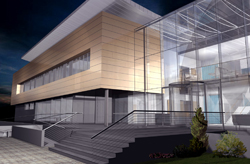
Clinical Research Centre prepares to welcome patients

Building work at the new £10.5 million Clinical Research Centre at Ninewells Hospital is nearing completion.
The custom-built "research hotel" has been designed in close cooperation with senior clinicians and aims to form a physical hub for research work carried out within the University and NHS Tayside.
Spanning two floors of a three storey building the CRC has its own entrance and reception area but is physically linked to the hospital and the new Translational Medicine Research Collaboration centre which is being built next door.
The lower floor has been designed to accommodate MRI and PET scanners including the scanner donated to the University last year by businessman Brian Souter.
This imaging floor also includes a minor procedure room linked directly to the scanner rooms, an X ray facility, a blood lab, a radioactive pharmacy and individual patient bays with TV and audio equipment.
The clinical research floor where patients will be based contains a range of different ward areas with facilities including medical gas provision and a specialist ward with air lock to provide stable environmental conditions to support particular research studies. It also has a physiology lab, blood labs, a satellite pharmacy, office accommodation and meeting rooms.
"This is a bespoke building," said project manager Guy Hickman. "The user group has been involved in the design process from day one. It has also been designed to be very flexible so that it can cater for all kinds of research.
"The idea is that investigators bring their research here for the duration of their study. There will be core equipment and there will be support and admin staff here permanently but research teams will come and go."
Lesley Peebles, lead for the user group, added that the CRC, which was designed by Boswell Mitchell Johnson architects, has been built to harness the potential for clinical research and meet the needs of researchers.
"It is a very flexible building and we have tried to future proof it," she said. "It is about being able to respond to what the investigators actually need."
The Centre is expected to welcome its first patients this Spring.
Next Page
Return to April 2008 Contact

